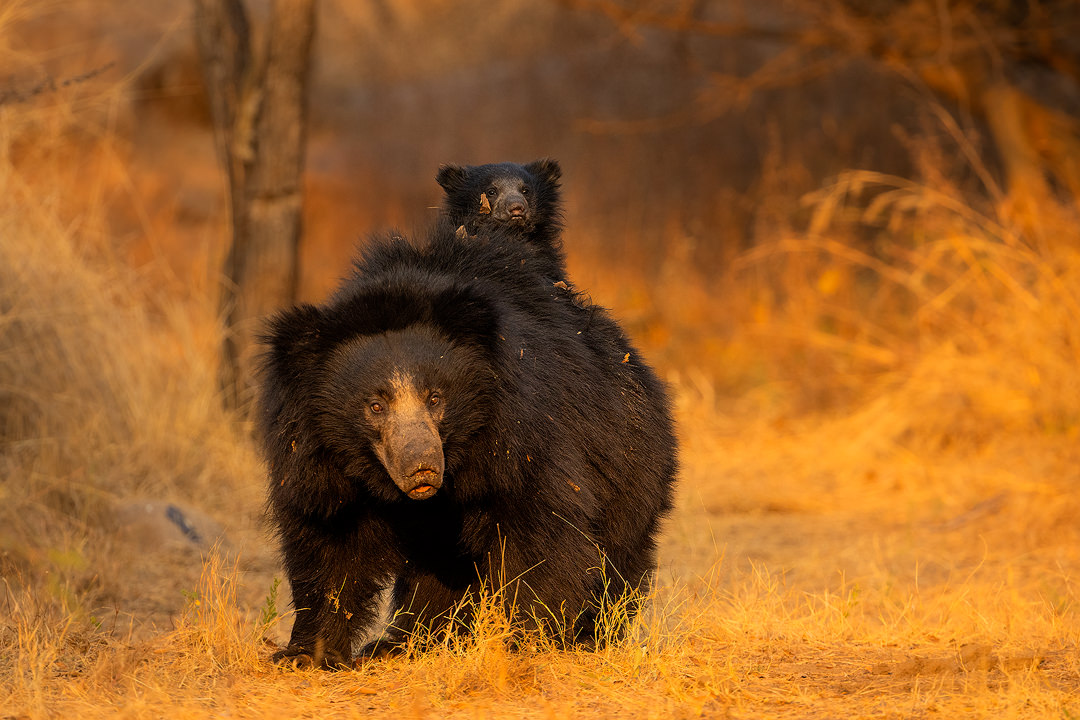Sloth bear cub piggyback
Sloth bear cub piggyback. Sloth bear mother cub riding piggyback in golden evening light. Sloth bears are the only species of bear to carry their young around like this, so cute! Karnataka, India.
Sloth bears are often overlooked and regarded as one of the ‘lesser’ animals of india and despite their highly vulnerable status there are little to no conservation efforts to help them. This, along with their typically shy and nocturnal habits, means that they are not an easy subject to study.
Sloth bear cub piggyback – About the Sloth Bear:
The sloth bear (Melursus ursinus) is a bear species in the family Ursidae native to the Indian subcontinent. They are listed as vulnerable on the IUCN Red List, largely due to habitat loss and persecution. These distinctive bears have shaggy black fur, a mane around the face, a yellowish-white ‘U’ or ‘Y’ shaped chest marking and long powerful claws. Male sloth bears can grow up to 6 ft tall and weigh up to 145 kg. The females are slightly smaller and lighter.
The sloth bear is the most numerous and widespread bear species found in India. They inhabit a wide range of habitats including both moist and dry tropical forests, scrubland and grassland, although they show a strong preference for forested areas.
Sloth bears are primarily nocturnal and omnivorous. Their diet typically consists of insects, fruits and flowers but will also scavenge carrion. A sloth bears favourite food is termites. Their strong sickle-shaped claws are perfect for ripping into termite mounds, which can be rock-hard and heavily fortified. Once they’ve opened a hole, they use their well adapted snouts to noisily suck out the insects like a vacuum cleaner, whilst closing their nostrils to ensure no insects can get inside. Sloth bears are excellent climbers and will climb trees to knock down bee hives, giving them the alternative name ‘honey bear’.
Breeding typically takes place between May and July, with the cubs born six to seven months later. A typical litter is one or two cubs although litters of three cubs have been observed. Unique amongst bears, the cubs often ride on their mother’s back. The cubs will stay with their mother for more than two years before moving off on their own.
Sloth bears are one of India’s most unpredictable and feared wild creatures and are widely regarded as the most dangerous wild animal in India. Attacks on people are common and often fatal. This human animal conflict is primarily due to a high number of densely populated areas surrounding national parks and reserves that are home to sloth bears. Based on numbers alone, the sloth bear is the world’s most dangerous species of bear.
Sloth bear Conservation:
IUCN estimates that just 8,000 – 10,000 sloth bears survive in the wild. Their rapidly declining population means they are classed as vulnerable on the IUCN Red List. India now has several protected areas dedicated to protecting sloth bears including Daroji, Gudekote, Shoolpaneshwar, Mount Abu and Jessore Sanctuaries.
Habitat loss and poaching are the primary threats to sloth bears. Over the centuries bears have been poached to be used as captive dancing bears and killed to obtain valuable animal parts for use in Asian medicine. Sloth bears are also regularly killed by farmers because of damage to crops and their reputation for aggression towards humans.
Whilst sloth bears can be aggressive, they typically only act in defense, reacting very strongly to potential threats. They are easily surprised and likely react with aggression due to viewing humans as predators.
The Sloth bear is listed as a Schedule I species in the Indian Wildlife Protection Act 1972, which grants the bears some legal protection from persecution and hunting, but allows bears to be killed in self-defence or in special circumstances where damage has been caused. Commercial trade of the sloth bear and their parts is strictly prohibited although it still occurs on the black market. The government of India has also banned use of sloth bears for entertainment.
Despite the ban on this barbaric practice, many sloth bears are still forced to perform as dancing bears. To combat this a ‘Sloth Bear Welfare Project’ in the country has been formed to put an end to their use for entertainment. Sloth bears previously used for entertainment are also being rehabilitated in rescue centres such as Agra Bear Rescue Facility.
In order to address the ongoing human-bear conflict, people must be educated about conservation, ethics, and how best to live side by side with the bears in peace.
The first step to resolving this conflict is to improve the bears deteriorating habitat, meaning they will not need to come so close to human settlements; the main reason behind the attacks. Limiting the amount of garbage, especially food waste, which tempts to bears close to towns and villages is also essential to reduce the number of accidental attacks on humans.
This excellent film “Living with Sloth Bears” aims to inform people about sloth bears and show them how to avoid and survive bear attacks.
You can find more about Sloth Bears here.
